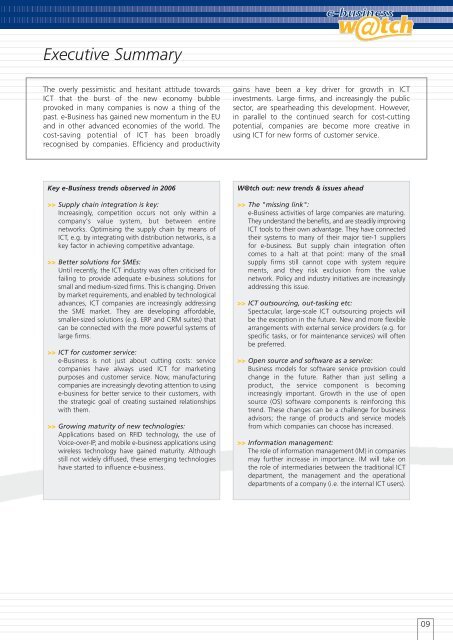The European e-Business Report The European e ... - empirica
The European e-Business Report The European e ... - empirica
The European e-Business Report The European e ... - empirica
- No tags were found...
Create successful ePaper yourself
Turn your PDF publications into a flip-book with our unique Google optimized e-Paper software.
Executive Summary<strong>The</strong> overly pessimistic and hesitant attitude towardsICT that the burst of the new economy bubbleprovoked in many companies is now a thing of thepast. e-<strong>Business</strong> has gained new momentum in the EUand in other advanced economies of the world. <strong>The</strong>cost-saving potential of ICT has been broadlyrecognised by companies. Efficiency and productivitygains have been a key driver for growth in ICTinvestments. Large firms, and increasingly the publicsector, are spearheading this development. However,in parallel to the continued search for cost-cuttingpotential, companies are become more creative inusing ICT for new forms of customer service.Key e-<strong>Business</strong> trends observed in 2006>> Supply chain integration is key:Increasingly, competition occurs not only within acompany's value system, but between entirenetworks. Optimising the supply chain by means ofICT, e.g. by integrating with distribution networks, is akey factor in achieving competitive advantage.>> Better solutions for SMEs:Until recently, the ICT industry was often criticised forfailing to provide adequate e-business solutions forsmall and medium-sized firms. This is changing. Drivenby market requirements, and enabled by technologicaladvances, ICT companies are increasingly addressingthe SME market. <strong>The</strong>y are developing affordable,smaller-sized solutions (e.g. ERP and CRM suites) thatcan be connected with the more powerful systems oflarge firms.>> ICT for customer service:e-<strong>Business</strong> is not just about cutting costs: servicecompanies have always used ICT for marketingpurposes and customer service. Now, manufacturingcompanies are increasingly devoting attention to usinge-business for better service to their customers, withthe strategic goal of creating sustained relationshipswith them.>> Growing maturity of new technologies:Applications based on RFID technology, the use ofVoice-over-IP, and mobile e-business applications usingwireless technology have gained maturity. Althoughstill not widely diffused, these emerging technologieshave started to influence e-business.W@tch out: new trends & issues ahead>> <strong>The</strong> "missing link":e-<strong>Business</strong> activities of large companies are maturing.<strong>The</strong>y understand the benefits, and are steadily improvingICT tools to their own advantage. <strong>The</strong>y have connectedtheir systems to many of their major tier-1 suppliersfor e-business. But supply chain integration oftencomes to a halt at that point: many of the smallsupply firms still cannot cope with system requirements, and they risk exclusion from the valuenetwork. Policy and industry initiatives are increasinglyaddressing this issue.>> ICT outsourcing, out-tasking etc:Spectacular, large-scale ICT outsourcing projects willbe the exception in the future. New and more flexiblearrangements with external service providers (e.g. forspecific tasks, or for maintenance services) will oftenbe preferred.>> Open source and software as a service:<strong>Business</strong> models for software service provision couldchange in the future. Rather than just selling aproduct, the service component is becomingincreasingly important. Growth in the use of opensource (OS) software components is reinforcing thistrend. <strong>The</strong>se changes can be a challenge for businessadvisors; the range of products and service modelsfrom which companies can choose has increased.>> Information management:<strong>The</strong> role of information management (IM) in companiesmay further increase in importance. IM will take onthe role of intermediaries between the traditional ICTdepartment, the management and the operationaldepartments of a company (i.e. the internal ICT users).09
















